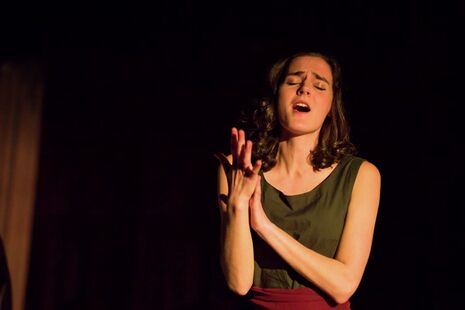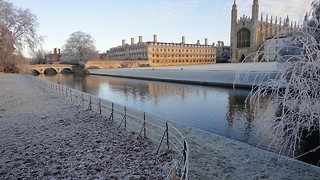Mary of Egypt
Charlotte Saul enjoys this breathtaking opera in the stunning surrounds of King’s Chapel

The whispers fade away and the lights go down in King’s Chapel. The mood is a somber one as the long drone on F subtly invites the audience into the world of this contemplative piece. As the flute gently swells, we are carried up and away, and for the next couple of hours, the audience and protagonists alike are cast into a wilderness of spiritual contemplation.
This performance of Mary of Egypt is a markedly special one; Theodora Tavener, the undergraduate daughter of the late Sir John Tavener, co-directs this UK premiere of the chamber scoring as a part of the 70th birthday celebrations for her father. The story follows Mary, the Egyptian prostitute-saint, and Zossima, an arrogant monk from Palestine. Both protagonists are called to renounce everything and go into the desert, where they meet 47 solitary years later, finding in one another a sense of spiritual ecstasy.
Set in the stunning King’s Chapel, it is immediately clear that Tavener and her creative team have made all the right choices. The chorus and orchestra are set either side of an empty stage, the symmetry of their positioning in pleasing correspondence with the symmetrical backdrop of the screen. The perpendicular architecture of the chapel, free from decorative flamboyance, mirrors the architecturally simple musical material.
Grounded in long lines and sustained notes, Byzantine chant-like intonations give the music its shape and color. It is these long, sustained notes that could potentially make Mary of Egypt difficult to sing, but the chorus proved ready for the challenge. The bass section, which sustains for longer and more frequent stretches, is to be commended.
There were moments, however, throughout the first two acts where the chorus lost sight of their musical leader. A unified sound was not immediately realized as some choristers hesitated with every loud percussion and brass punctuation. Similarly, Nick Doig’s Zossima struggled in the first two acts, appearing uncomfortable and with an unfortunate tendency to over-sing, especially at the top. But all this changed after the interval. Doig returns to the stage a new man, reveling in the beauty of his duet 'Bless', challenging and quickly upending any previous question as to his abilities as singer and actor.
Camilla Seale’s Mary was breathtakingly beautiful from start to finish. As Seale connects in choreography with a team of six impressive dancers, the creamy fluidity of her voice finds its match, not initially with Doig, but with James Hodgson on flute. Susie Self’s The Voice, a hidden and unembodied role, proves similarly flawless throughout. Self is solid in all registers and as her voice soars through the trumpeting angels atop the chapel organ, the Divine feels at once intimate and vast.
The singers alone do not create this performance. The clever lighting, the dancers’ combination of sexuality and spirituality, the way the light casts long, mesmerizing shadows on the chapel walls, the full flute lines and the all-around able and talented orchestra and chorus led by Philip Barrett, all combine to create a truly fascinating event.
As Doig leaves the stage and walks through the doors of the screen in the final scene, all elements come together to create a transcendent moment. Lights are extinguished but the lit candles through the door and behind the screen allow the audience to glimpse at what lies beyond. With the monk’s crossing into that eternal misty glow, through doors that have remained open from start to finish, we are reminded of divine immutability. With this open door visual, the refrain 'the ways to salvation are more than one' resounds, when in reality, only the F drones on.
 Comment / Anti-trans societies won’t make women safer14 November 2025
Comment / Anti-trans societies won’t make women safer14 November 2025 Comment / Be mindful of non-students in your societies12 November 2025
Comment / Be mindful of non-students in your societies12 November 2025 News / Stolen plate returned to Caius after 115 years12 November 2025
News / Stolen plate returned to Caius after 115 years12 November 2025 News / Controversial women’s society receives over £13,000 in donations14 November 2025
News / Controversial women’s society receives over £13,000 in donations14 November 2025 Theatre / The sultry illusions and shattered selves of A Streetcar Named Desire13 November 2025
Theatre / The sultry illusions and shattered selves of A Streetcar Named Desire13 November 2025








